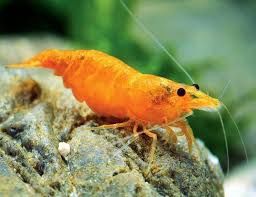Orange Pumpkin Shrimp
Orange Pumpkin Shrimp Care Guide
Tank Setup
-
Tank Size: Minimum 20 liters (5 gallons) for a small colony. Larger tanks allow the shrimp to thrive and breed more successfully.
-
Substrate: Dark sand or gravel enhances their bright orange color.
-
Décor: Provide mosses (Java Moss, Christmas Moss), driftwood, cholla wood, and plenty of hiding spots. They love fine-leaved plants for grazing and shelter.
-
Lighting: Moderate – helps plant and algae growth, which shrimp feed on.
Water Parameters
-
Temperature: 20–26°C (68–79°F)
-
pH: 6.5–7.5
-
Hardness: 4–12 dGH
-
KH: 3–8 dKH
-
Filtration: Gentle sponge filter is ideal – safe for baby shrimp and provides biofilm for grazing.
Diet
-
Omnivores – feed a mix of high-quality shrimp pellets, algae wafers, and blanched vegetables (zucchini, spinach, cucumber).
-
They also graze constantly on biofilm, detritus, and algae.
-
Supplement occasionally with protein-rich foods like daphnia or crushed bloodworms.
Tank Mates
-
Best in a species-only shrimp tank for maximum survival and breeding.
-
If kept in community tanks, suitable tank mates include small, peaceful fish such as ember tetras, micro rasboras, and otocinclus catfish.
-
Avoid larger or aggressive fish that may prey on them (like bettas, cichlids, or barbs).
Behavior
-
Peaceful and social, happiest in colonies.
-
Active grazers that help clean the aquarium.
-
Females are more brightly colored and larger than males.
-
Adults reach about 2–3 cm (1–1.2 inches).
Breeding
-
Very easy to breed in freshwater.
-
Females carry 20–30 eggs under their abdomen for about 3–4 weeks until hatching.
-
Shrimplets look like miniature adults and feed on biofilm and powdered shrimp food.
-
Stable water parameters are key to successful breeding.
Interesting Fact
Orange Pumpkin Shrimp are selectively bred from the wild Neocaridina davidi, the same species as Cherry Shrimp. Their pumpkin-orange coloration was developed through careful breeding, making them a favorite for aquascapers who want a bold pop of color in planted tanks.

